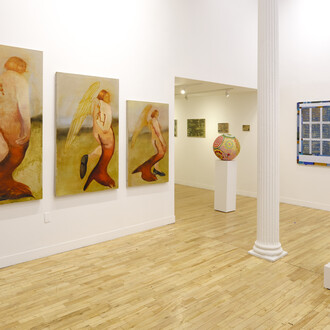My pictures are full of climates, abstract climates, and not nature per se. But a feeling. And the feeling of an order that is associated more with nature. Nature in seasons, maybe; but nature in, well, an order. And I think art itself is order out of chaos.
(Helen Frankenthaler)
Gagosian is pleased to announce Drawing within Nature: Paintings from the 1990s, an exhibition of twelve paintings and three large-scale works on paper by Helen Frankenthaler. This will be the first time in almost two decades that a group of the artist’s paintings from this era have been presented in New York, with some that have never previously been exhibited.
Frankenthaler’s celebrated 1952 composition, Mountains and Sea, was the first of her soak-stained canvases and was highly influential in the development of 1960s Color Field painting. By the 1970s, though, she had amplified her methods to include the expressive possibilities of surface inflection and density. Over the course of the 1980s, highly painterly canvases became her principal pictorial means, soon resulting in, during what would be her final decade, canvases of the greatest dramatic impact of her entire career, some of an unexpectedly large size.
Drawing within nature features works dating from 1990 through 1995, made following Frankenthaler’s paintings retrospective which opened in 1989 at the Museum of Modern Art, New York. Composed in her studios in New York; Stamford, Connecticut; and Santa Fe, New Mexico—where she held a summer teaching residency at the Santa Fe Institute of Art in 1990 and 1991—these abstractions are inspired by the artist’s experience of landscapes.
Works in the exhibition include Poseidon (1990), more than eight feet wide, which calls on qualities of Frankenthaler’s earlier soak-stained canvases to evoke ocean currents, with its wet-on-wet passages of aqua, white, and green. The even larger Stella Polaris (1990) sets streams and patches of dense cloudlike white paint beneath the starlight of its title. Western Roadmap (1991) transforms the desert rock and glowing sunsets of the American Southwest into a stratified abstraction that hangs within an almost nine-foot-wide panorama. Reef and Spellbound (both 1991) lay out washes of rich, glowing color of varying density across dark grounds. The verdant hues of The Rake’s Progress (1991) suggest a garden in bloom, and show how Frankenthaler began to use gel to thicken her paint as well as combing and raking tools to create tracks bearing the imprint of the energy passing over the surface.
Painted a few years later, in acrylic on large sheets of paper, Acrobat, Flirt, and Aerie (all 1995) are less grounded in memories of landscape vistas. Rather, their open, cursive forms invoke vividly colored and magnified details of drawing within nature.
The exhibited works were selected by John Elderfield and Jason Ysenburg in collaboration with the Helen Frankenthaler Foundation. An accompanying catalogue, illustrated with color plates and photographs of the artist in her studio, includes a new essay by art historian Thomas Crow.
Helen Frankenthaler (1928–2011) is represented in major public and private collections worldwide. Her work has been the subject of three major monographs and numerous solo museum exhibitions, including the Jewish Museum, New York (1960); Whitney Museum of American Art, New York (1969); Works on Paper 1949–1984, Solomon R. Guggenheim Museum, New York (1985, traveled extensively throughout the United States and Canada, 1985–86); A Paintings Retrospective, Museum of Modern Art, New York (1989, traveled to Modern Art Museum of Fort Worth, Texas, 1989–90; Los Angeles County Museum of Art, 1990; and Detroit Institute of Arts, 1990); Prints, National Gallery of Art, Washington, DC (1993, traveled to San Diego Museum of Art, 1993; Museum of Fine Arts, Boston, 1994; Contemporary Arts Center, Cincinnati, 1994; Machida City Museum of Graphic Arts, Japan, 1994); Paintings on Paper (1949–2002), Museum of Contemporary Art, North Miami, FL (2003, traveled to Royal Scottish Academy, Edinburgh, 2003); Giving Up One’s Mark: Helen Frankenthaler in the 1960s and 1970s, Albright-Knox Art Gallery, Buffalo, NY (2014–15); Pittura/Panorama: Paintings by Helen Frankenthaler, 1952–1992, Museo di Palazzo Grimani, Venice (2019); Radical Beauty, Dulwich Picture Gallery, London (2021–22); Late Works, 1990–2003, New Britain Museum of Art, CT (2021, traveled to Weatherspoon Art Museum, University of North Carolina, Greensboro, 2021; Palm Springs Art Museum, CA, 2021–22; and Baker Museum, Naples, FL, 2022–23); and Painterly Constellations, Kunsthalle Krems, Krems an der Donau, Austria (2022, traveled to Museum Folkwang, Essen, Germany, 2022–23).
















